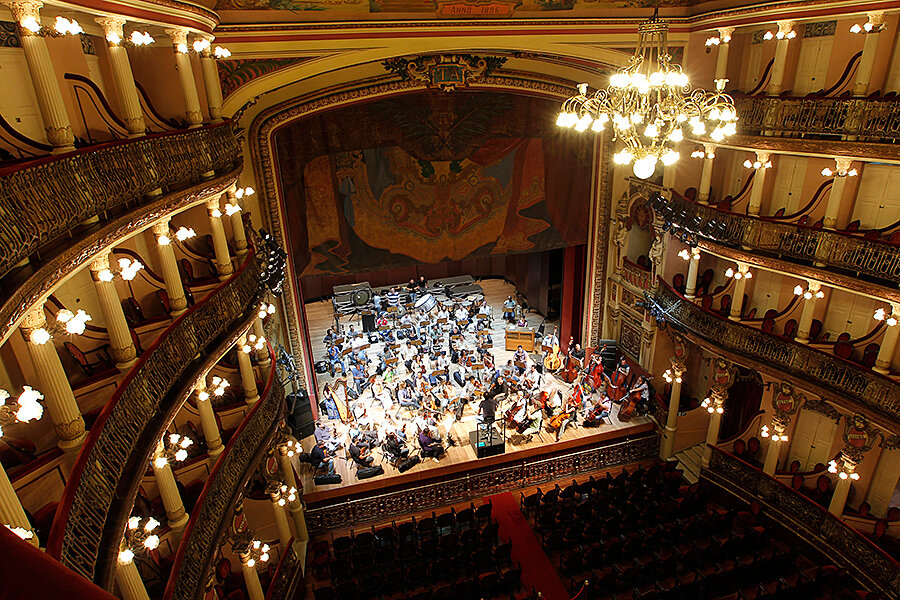World Cup city Manaus: Brazil's 'Paris' in the Amazon?
Loading...
| Manaus, Brazil
Nearly 115 years before a multi-million dollar soccer stadium was plopped down in the middle of the Amazon for next month’s World Cup, this city had another idea for world-class entertainment.
Building an opera house in the world's largest rainforest was a Herculean task. For 12 years, workers had to haul all the materials – gold from Brazil; iron from Scotland; chandeliers from France and Venice; marble from Portugal and Italy – 1,000 miles up the Amazon River. By 1896, their job was done, and the Teatro Amazonas opened.
A legacy of the rubber boom, the opulent theater still stuns visitors to Manaus. The main hall boasts four levels, 686 seats, 90 boxes, and a grand ceiling painted to resemble the underbelly of the Eiffel Tower. It’s as if one were seated at the center of Europe’s cultural capital instead of on the banks of a piranha-filled river.
“We were considered a jungle Paris,” says Robério Braga, secretary of culture for the state of Amazonas, during an interview inside the theater’s European-style cafe. “All the new things in Europe we had first, before Rio de Janeiro or Sao Paulo.”
Few other signs of this city’s former glory remain. Hardly a decade after the pink neoclassical Teatro Amazonas was completed, the city lost its short-lived monopoly on global production of rubber. Malaysia took over as the world’s rubber capital, and a slow downward spiral began. The old cobblestone streets — made from stone imported from Portugal — are now paved and lined with drab concrete buildings. All that remains of an electric streetcar service that opened in 1899 are a few half-buried street rails; today Manaus suffers regular power blackouts.
Teatro Amazonas itself was abandoned from 1924 until 1997. Mr. Braga was appointed secretary of culture in 1996, and worked to bring the opera back to the jungle, and its rebirth coincided with Manaus’ establishment as an industrial hub, and Brazil’s emergence as an economic powerhouse. Since then, Brazilian dancer Ana Botofogo and Russian choreographer Mikhail Baryshnikov have taken the stage. The annual Amazonas Film Festival, introduced in 2002, has attracted participants such as actor Matt Dillon and director Roman Polanski.
Teatro Amazonas' construction was itself the inspiration for "Fitzcarraldo," a 1982 movie that explored the grandiose dream of a rubber baron to build an opera house in the Amazon. In the film, the protagonist forces indigenous workers to drag a river boat over a mountain, a flight of cinematic fancy that didn't happen here.
On a recent hot and humid evening typical of this equatorial city, the sound of an Italian soprano fills the main hall of the opera house. It’s a sold-out production of Lucia di Lammermoor, part of the annual Amazonas Opera Festival that runs through June. The sloping stage fills with a cast of some 50 singers accompanied by a full orchestra.
Some 450,000 tourists visited Manaus last year, and 98 percent came to gaze up at opera house's iconic dome decorated with thousands of ceramic tiles painted green and yellow like the national flag, says Braga.
Symbol of rebirth
The government’s annual subsidy of 150 million real ($67 million) allows the opera to sell tickets from as little as 5 real ($2.25) up to 80 real ($35.75), and to fund numerous other arts festivals and educational opportunities, says Braga. The opera regularly sells out, and some 55,000 people, from toddlers to university students, are currently studying voice, instruments, dance, and film through the theater, he says.
Teatro Amazons, while still a symbol of the city's boom-to-bust a century ago, is now a symbol of its rebirth. It stands in relief to the city’s new 42,000-capacity Arena Amazônia, an undertaking that some saw as equally improbable. While the Teatro Amazonas was originally built by private money for resident opera enthusiasts, the new stadium was built using public funds for a city of 1.8 million without a major fan base.
Braga is confident the new stadium, which will host soccer matches for England and USA in June, will grow into its own. He calls it “an investment,” a way for Manaus to grab the spotlight as the World Cup draws some 600,000 foreign visitors to Brazil. To capitalize on the influx of tourists, Braga says he’s organizing a cultural fair during the matches and will keep the opera house and other cultural sights open late.
“It’s good for us because we will be seen by the world,” he says. “It will show that we are in the middle of the jungle but we are a modern city.”
Editor's note: A previous version of this post misstated the first name of the secretary of culture.








